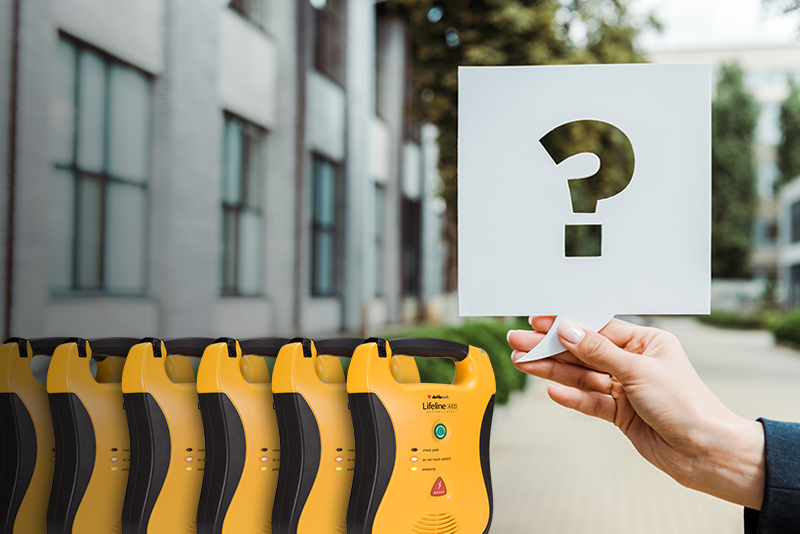How Many AEDs Should Be in a Building?
March 16, 2022

With sudden cardiac arrest taking the lives of hundreds of thousands of people each year, it is crucial all facilities are equipped with an AED. We often hear people say that since they have an AED in their facility, they are prepared for a sudden cardiac arrest emergency. This is not necessarily true. It is important to have a complete AED Program to ensure the highest chance of survival.
The following components are included in a complete AED program and can help ensure the highest chance of survival from sudden cardiac arrest.
AEDS
Having just one AED is NOT enough! AEDS should be accessible within 3 minutes of all locations. Statistically, if someone is shocked within one minute of suffering a sudden cardiac arrest, they have a 90% chance of survival. Each minute after decreases their chances of survival 10%. AEDS should be strategically placed throughout a facility and on each floor. They should be placed so they are always accessible within 3 minutes.
Program Management
The first step is to ensure your AED is ALWAYS read to save a life.
AEDs require minor maintenance and must be checked monthly. When checking your AED, here are some things you should look for:
• Is the readiness indicator on your AED flashing green?
• Does the AED appear to be undamaged and ready for use?
• Is the AED free of chirping and warning notifications?
• Are the AED supplies (CPR/AED rescue kit and electrode pads) available and within their usable dates?
If you answer “no” to any of these questions when checking your AED, you should service your AED right away!
AED batteries can last anywhere from 4-7 years. They should have an expiration date on the battery pack so you know exactly when to change them. Make sure you order them in advance, so you have them before the current battery expires!
Pads last two years whether they are used or not. They also will have an expiration date on them. Always keep a spare supply of the battery pack and pads on hand to ensure your AED is always ready for use!
Using a program management system is a great way to maintain your AED.
Defibtech offers DefibtechMD, which provides a best-in-class Customer Service team who is ready to help you get the most out of your AED.
Cardiac Emergency Response Team
It is important that you have a large group of people who are prepare to provide CPR and use the AED if needed. This group of people should have CPR/AED/First Aid Certification that is current. Most certifications last two years so it is important to keep them up to date. A list of your Cardiac Emergency Response team should be maintained and updated frequently. This list should include name, CPR/AED training expiration date, location (office/classroom), and phone number. These people should be contacted immediately in the event of a cardiac emergency.
The responsibilities of the members of the Cardiac Emergency Response Team include:
• Ensure the Cardiac Emergency Response Plan is current and consistent with local, state, and federal law.
• Meet frequently to evaluate the effectiveness of the Cardiac Emergency Response Plan.
• Communicate the Cardiac Emergency Response plan with other members of the office or school.
• Incorporate a certification plan to ensure all members are up to date on their certification.
• Run drills to ensure everyone knows their role within the Cardiac Emergency Response Plan.
Cardiac Emergency Response Plan
Finally, you need to have a Cardiac Emergency Response plan that is written and reviewed frequently. This plan should include:
• Development of Cardiac Emergency Response Team
• The activation of the Cardiac Emergency Response Team
• AED Placement and Maintenance
• Communication of this plan to all staff
• Cardiac Emergency Response Drills
• Engage Local Emergency Medical Services (EMS) and integrate them into your plan
• Review and evaluate the Cardiac Emergency Response Plan annually
Remember, having an AED is important, but it is NOT enough. Combining the AED with good program management, a prepared Cardiac Emergency Response Team, and an efficient Cardiac Emergency Response Plan will ensure that someone in sudden cardiac arrest has the absolute best chance of survival.
Follow these steps and your facility will be doing everything to ensure high chances of survival from sudden cardiac arrest.
To learn more about Defibtech and to join us on our quest to save lives from sudden cardiac arrest, visit www.Defibtech.com.
Sources:
https://parentheartwatch.org/get-involved/get-an-aed/
https://parentheartwatch.org/resources/sca-prevention/cardiac-emergency-response-plan/
https://parentheartwatch.egnyte.com/fl/bQJZtul05n#folder-link/
